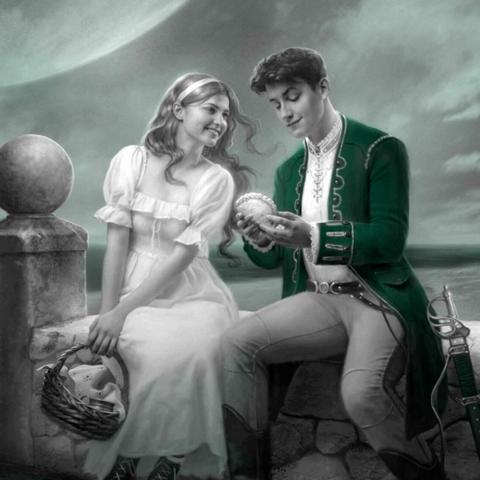Amid the dragon hoards, warring nations, tangled political landscapes, and demonic antagonists, there is a sub-genre within fantasy fiction called "cozy fantasy." You’ve probably seen it all over your Goodreads feed and Barnes and Noble newsletters. Warm, bright, and comforting stories are dominating the industry right now, and for good reason. The past few years kept us locked in our houses and essentially siloed us from each other. That familiar sense of warmth was absent during the pandemic, and it may be fair to say the anxious chill it was replaced with still clings to our bones.
The antidote? Cozy fantasy books.
Brandon Sanderson did indeed write these Secret Projects in a cave during COVID. But, to be fair, it’s a really nice cave.
That might’ve been Brandon Sanderson’s thought process when he wrote Tress of the Emerald Sea in the middle of lockdown, the first of the legendary Secret Projects. Tress is a heartwarming, seafaring, spore-dodging cozy fantasy where the princess isn’t useless. She’s not even a princess—but Tress of the Emerald Sea is a retelling of sorts in the style of The Princess Bride.
Luckily, most of the world agrees that cozy fantasy does a fantastic job warming our hearts. With the rise of cozy fantasy fiction, we’ve seen some spectacular titles make their way to our shelves. Let’s dive into what makes this sub-genre so attractive and send you home with a list of our favorites at Dragonsteel.
What is Cozy Fantasy?
An excellent question, especially for high or epic fantasy enthusiasts. Cozy fantasy is a sub-genre of fantasy that lowers the stakes and invites you in for a warm cup of tea. Much like cozy mysteries, these stories focus on interpersonal character relationships over political intrigue.
While the fantastical elements remain—magic, mythical creatures, and otherworldly settings—the tone is much lighter, with emphasis on personal journeys, community bonds, and low-stakes challenges rather than world-ending dangers. Usually, the heart of the story is not about saving worlds, but about finding contentment in everyday life.
In some ways, this trend could be seen as a genre-fication of character development and interpersonal relationships in fantasy. If these books were set in our modern world, they might simply be called fiction due to their literary emphasis on the character’s internal conflict and journey.
These books often take place in quaint locations within a bigger world, such as in a small town, a library, a neighborhood, an inn, a forest, and so on. Instead of being epic, world-traveling adventures, they’re stories of internal conflict. Due to the smaller scale, these books require a different worldbuilding approach.
Of course, as with all genres, these are generalizations. Think of the above as observations, not strict truths. A cozy book to you might mean something totally different than to me. These are simply recurring motifs in many popular titles.
Potential Themes in Cozy Fantasy
Though each story is unique, the following are themes that may make a novel more cozy than epic.
1. Low-Stakes Conflicts
Unlike epic fantasy, where entire realms might hang in the balance, cozy fantasy often focuses on personal or community-level challenges. A shopkeeper might face trouble keeping their business afloat, or a magical creature might need help olving a mystery. There’s tension, but it’s the kind that makes you smile, knowing everything will likely turn out just fine in the end.
(You might even say it’s about the journey before the destination. 👀 Though, our favorite Bridge Crew doesn’t get many low-stakes challenges.)
2. Character Relationships
In cozy fantasy, the focus is often on the bonds between characters. Whether it's friendships, families, or communities coming together, these stories thrive on the interactions between everyday people in magical settings. The emotional stakes tend to be about personal growth, healing, or finding one’s place in the world rather than facing down a dark overlord who may or may not be God. (Looking at you, Kelsier.)
3. Wholesome Tone
One of the main reasons readers are drawn to cozy fantasy is the lighthearted, positive tone. Even when there’s conflict, the vibe usually tends to stay optimistic. You typically won’t find gritty realism—instead, the stories lean more towards warm resolution than harsh realities. That’s not to say cozy fantasy doesn’t shy away from problems, but the resolution is often encouraging and witty.
4. Everyday Magic
In cozy fantasy, magic is often more subtle and integrated into the characters' everyday routines. It might be used to bake enchanted pastries, tend to magical plants, or craft a perfect cup of tea. Unlike the kind of hard magic you’ll often find in Brandon Sanderson’s epic universe, magic in these stories often doesn’t come with complex rules or epic quests. Instead, it may enhance the ordinary, making daily life more enchanting.
5. Charming Settings
The settings of cozy fantasy are often picturesque: a quaint village by a lake, a cozy inn nestled in the mountains, or a small town where magic seeps into every corner. These locations evoke a sense of home and comfort, and are as much a part of the story as the characters who inhabit them.
Your Prescribed Reading List: 5 Cozy Fantasy Titles to Start With

1. Tress of the Emerald Sea by Brandon Sanderson
Tress, a cup-collecting girl from a small island, sets off on a whimsical journey filled with pirates, magical spores, and the power of storytelling. Though part of Sanderson’s larger Cosmere, Tress of the Emerald Sea brings an unmistakable charm. The stakes are personal, the friendships heartwarming, and the adventure unfolds with lightheartedness and wonder—a perfect blend of cozy and epic fantasy.
2. Legends and Lattes by Travis Baldree
This breakout indie hit features an orc who, after years of adventure, decides to settle down and open a coffee shop. Idyllic, right? Set in an idyllic fantasy town, the book focuses on the trials and joys of running a small business in a magical world. The complication is that our protagonist is tasked with introducing the town’s residents to coffee for the first time.
With its cozy setting, delightful cast of characters, and gentle humor, this story really embodies the heart of the genre.
3. The House in the Cerulean Sea by TJ Klune
This novel tells the story of Linus Baker, a quiet, bureaucratic man who works for the Department in Charge of Magical Youth. When he’s sent to investigate a mysterious orphanage housing some of the most dangerous magical children, what he finds is something far more heartwarming than he expected. Filled with love, acceptance, and whimsy, this book is a pillar of cozy fantasy for good reason.
Plus, the sequel just released, so it’s a great time to start reading.
4. Warbreaker by Brandon Sanderson
Because Warbreaker has its moments of intrigue and tension, this Cosmere book is often overlooked as a cozy read. Sanderson’s tale of gods, royalty, and breath-based magic has a warmth to it. That vibe resonates through the colorful settings and complex relationships between the characters. Siri and Lightsong, in particular, add a personal touch to the grander, more political machinations. For that reason, we think Warbreaker is a must-read for cozy fantasy fans who still enjoy a bit more intrigue.
5. Howl’s Moving Castle by Diana Wynne Jones
Ah, a classic of the genre. Cozy fantasy before it was cool, if you will. This novel follows Sophie, a young woman who’s cursed to live in the body of an old lady. Her journey takes her to Howl’s ever-moving magical castle, where she encounters a wizard who is as charming as he is exasperating. This story is full of wit, heart, and whimsy, offering a cozy adventure with a magical twist.
Why Cozy Fantasy Matters
At this point, it’d be valid to wonder: Why does cozy fantasy matter? Why has this sub-genre taken over the book community? Because cozy fantasy is so accessible, it is easy to get into no matter what genres your typically read. These books allow everyone to connect to a magical, peaceful storytelling rhythm.
As seen in books like Tress of the Emerald Sea, these stories celebrate quiet heroism—the kind that doesn’t (usually) involve defeating a dark lord, but instead highlights kindness, perseverance, and community. The magic in these books often feels as comforting as a warm fire on a cold night, reminding us that not all fantasy has to be dark and gritty. That’s one of the most exciting things about this trend—a deeper understanding that fantasy has more than just one tone. It’s a multidimensional and versatile genre worth exploring for all readers.
If you want to get started with cozy fantasy for free, check out our blog post for free sample chapters of Tress of the Emerald Sea (plus, get the first 20% of the audiobook on our YouTube channel).




Comments (1)
Warning: This comment contains spoilers for themes and plot points in Warbreaker.
Given the definition of cozy fantasy and the section in the article providing examples of common themes, I don’t understand how anyone can include Warbreaker on this list in good conscience. Below are examples from Warbreaker that I believe show that it completely contradicts the definition of a “cozy” book as defined by this article.
The article suggests that cozy fantasy typically involves low stakes. Warbreaker is a story with extremely high stakes. Three nations are in turmoil, and the events of Warbreaker will determine their fate. The entire political landscape of Nalthis hangs in the balance, with threats of war on a national scale.
While Warbreaker does heavily revolve around character relationships, these relationships are the antithesis of “cozy.” At the start of the book, Siri is taken against her will to become the wife of someone she perceives to be a cruel and heretical “God King” to produce an heir. The prim and proper Vivenna ends up so destitute that she considers prostitution to avoid starving to death. Nightblood is literally murder incarnate, and Vasher is a man haunted by the murders and failures of his past. All of these character arcs end on a positive note, but they get there by taking very dark paths in many cases.
Although the previous examples I’ve provided likely suffice to explain why I think Warbreaker does not have a wholesome tone, here’s an excerpt to further emphasize the point:
“The priest by his cage sighed, then waved a hand at the others. They unlocked Blushweaver’s cage and pulled her out. She yelled and fought, and Lightsong smiled at the trouble she gave them. Yet there were six priests, and they finally managed to get her out.
Then one got out a knife and slit her throat.
The shock of the moment hit Lightsong like a physical force. He froze, eyes wide, watching in horror as the red blood spilled out the front of Blushweaver’s throat, staining her beautiful nightgown.
Far more disturbing was the look of panicked terror in her eyes. Such beautiful eyes.
“No!” Lightsong screamed, slamming against the bars, reaching helplessly toward her. He strained his godly muscles, pressing himself against the steel as he felt his body begin to shake. It was useless. Even a perfect body couldn’t push its way through steel.
“You bastards!” he yelled. “You Colors-cursed bastards!” He struggled, pounding the bars with one hand as Blushweaver’s eyes began to dim.”
Everyday magic is probably the aspect of Warbreaker that comes closest to fulfilling the “cozy” criteria. BioChroma is something natural to the people of Nalthis. However, Breath becomes commoditized due to the ease with which it can be transferred from person to person and the need for the Returned to constantly be given more Breath to survive. This system leads to corruption and abuse, which becomes a major theme of the book, making the magic system far less cozy than it might otherwise be. Brandon’s laws of magic in general don’t promote cozy magic. There are limitations and costs. Cosmere magic systems are designed with intent to create narrative tension and drama.
We aren’t sure whether Warbreaker will end well until the very end of the book! It is dramatic, gripping, and stressful. I love it—it’s one of my absolute favorite books in the Cosmere. However, by marketing it as “cozy” in an article intentionally formatted for SEO, you risk misleading new readers and turning them off from the Cosmere when their “cozy” read starts off with multiple chapters of Siri waiting (initially in terror) for Susebron to have his way with her.
I think the other recommendations on the list are great examples of cozy fantasy. However, by shoehorning Warbreaker into a list where it doesn’t belong, everything else in the article is tainted by its presence, revealing the article as nothing more than copywriting disguised as content which was created solely to promote Brandon’s books.